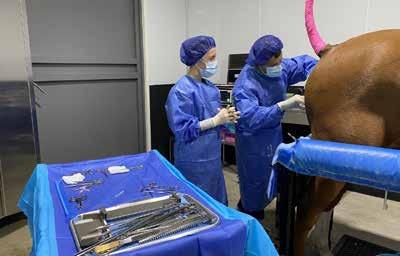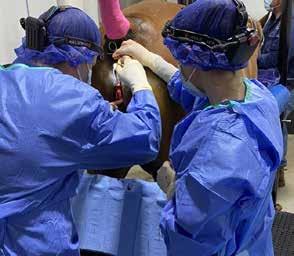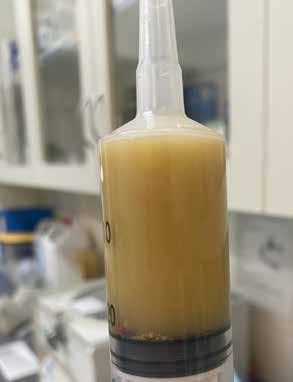
7 minute read
TECHNICIAN UPDATE
The retrieval bag enclosed most of the stone, so it could be broken up into smaller pieces and minimize any further mucosal irritation.Standing Perineal Surgery for Cystolith Removal in a Stock Horse Gelding
By Rebecca Cameron AssocDAppSc (Equine), BVetTech, RVT, VTS -EVN
Cystoliths, more commonly known as “bladder stones,” are an uncommon condition in horses in which hard ‘stones’, typically made up of concentrated minerals, are formed in the bladder. Equine urine is typically alkaline and has a high mineral content providing a suitable environment for cystolith formation. Cystolith removal in horses is usually preformed under general anaesthesia.
A 13-year-old stock horse gelding, presented to the equine hospital for stranguria and pigmenturia after competing the previous day. The horse was seen 5 days previously by a referring veterinarian for the same complaints.
Examination
A physical examination was performed and all parameters were found to be within normal limits. The bladder was aseptically catheterized to obtain a urine sample for analysis. There was evidence of blood in the urine with no bacteria present. Endoscopy of the bladder was also performed and revealed a large stone with a spiculated surface, approximately the size of a lemon. There was also evidence of mucosal irritation.


Surgery was booked for the following day because of the size of the cystolith and the degree of discomfort it was causing the horse. Due to the gelding’s calm temperament and the cost constraints of his owner, he was a good candidate for standing surgery. Standing cystolith removal has been performed more commonly in mares via the external opening of the urethra. In males a perineal urethrostomy (PU) is performed, which involves an incision below the anus into the urethra.
On the morning of the surgery, administration of pre-operative antimicrobial therapy including procaine penicillin intramuscularly, IV gentamicin and the non-steroidal anti-inflammatory drug (NSAID), IV phenylbutazone. The left jugular was aseptically prepared and catheterized with a 14 Ga angio catheter and sutured in place. The gelding was premedicated with acepromazine, methadone and detomidine, then walked into the standing surgical crush where he was started on a detomidine constant rate infusion (CRI) and a maintenance rate of Hartmanns.
The coccygeal area was clipped and aspectically prepared for the administration of a caudal epidural between C1 and C2. Xylazine and lignocaine were given for the epidural. Epidurals can aid in desensitization of the anus, rectum, perineum, vulva, urethra and bladder.
Equine urine is typically alkaline and has a high mineral content providing a suitable environment for cystolith formation.
Administration of a caudal epidural is generally considered a safe procedure, although complications can occur, including infection and ataxia.
The surgical plane was assessed continuously with the aid of the Ghent standing sedation algorithm. The Ghent algorithm was developed to assess sedation depth, ataxia and surgical conditions and/or adjust the dose or administration rate of alpha-2-agonists in horses.
Once an adequate plane of anaesthesia was achieved, which in this case was sedated enough to not respond to outside noise or intervention. The tail was wrapped and secured to the side while a sterile urinary catheter was placed and the perineal area surgically prepared following aseptic protocol.
The cystolith was removed with endoscopic guidance through the PU site using a retrieval bag. The retrieval bag enclosed most of the stone, so it could
be broken up into smaller pieces and minimize any further mucosal irritation. The surgery took a long time due to the size and compacted consistency of the stone. Constant monitoring and top ups of analgesia were required as well as the use of local blocks with mepivacaine. After removal of the cystolith, the bladder was then thoroughly lavaged.


The following day, the bladder was lavaged under endoscopic guidance to ensure no further debris remained. This step is particularly important, as any small fragments have the potential to lodge in the urethra and cause complete blockage of the urinary tract. This procedure confirmed that the surgery was successful, and full removal of the cystolith and any debris in the bladder was confirmed.
The gelding remained in the hospital overnight where he was regularly monitored and had physical examinations conducted every 6 hours. Urine and fecal output also was recorded. The surgical incision was cleaned and monitored for any discharge, and petroleum jelly was applied around the incision to minimise urine scalding.
Discharge was the following day continuing with calesulpha-T paste (trimethoprim-sulfadimidine) orally twice daily (BID) for 14 days and the NSAID, flunixin meglumine BID for the first 3 days, and then orally once a day or another 4 days.
The PU site will naturally close on its own in a couple of weeks, and until this time intermittent urination may be observed from both the penis and the PU site. Until the site is closed completely, the area and down the back legs should be cleaned daily with warm water and mild soap followed by a light coating of petroleum jelly to prevent urine scalding, the owner was told. His tail was kept in a rectal sleeve to help keep the tail and surgical area clean until completely healed.
It was recommended to keep the gelding in a stall by himself with hand walking or turnout in a small yard so his attitude, appetite and behaviour could be monitored.
Performing surgeries standing is often more cost effective and associated with reduced healing time.
Alpha 2-agonists represent the main class of sedatives for standing surgery. The use of drug combination and CRIs are recommended to provide a balance and steady state of sedation and analgesia for the duration of the procedure. Anesthesia, sedation depth, sedation quality and degree of ataxia were all continuously recorded using the Ghent sedation algorithm as a guide.
The total length of surgery was 6 hours. It is important in these instances to consider the duration of action of the opioids used for analgesia. Methadone has a duration of action of 5 hours. There were noticeable changes in the geldings demeanor and comfort levels after 4 hours, which correlated with the duration of action of the methadone given as a premedication. As a result, he received a bolus of methadone, and the detomidine CRI was increased until he was comfortable again, then CRI was decreased back to the original dose.
Ongoing Care
Horses who have formed calcium carbonate stones are at a higher risk for reforming them. Therefore, it is essential that diet is managed appropriately to prevent reformation of more cystoliths. Grassy hay was recommended instead of lucerne hay, which will decrease the amount of calcium in his urine. In addition to the diet adjustment, it was recommended that daily salt be added to his feed to encourage increased water intake. This gelding made a successful recovery from surgery, and was back to competing successfully a short time later. MeV
Teaching Points
Patient selection and preparation are critical aspects for a successful standing procedure. Equine general anesthesia has been reported to have the highest complication rates of all domestic species with an anesthetic-related mortality of 1% for elective procedures and up to 10% for emergencies, along with the risk for myopathies and neuropathies due to the pressure of the large body weight on bony prominences.
Advances in sedative and local anesthetic techniques ensure many procedures that were once only performed under general anesthesia can now be performed safely while the patient is standing.
About the Author
Rebecca Cameron is a VTS-EVN working as a clinical anaesthetist at Scone Equine Hospital in Australia. She first studied applied science, majoring in Equine Science, and then completed a Bachelor of Veterinary Technology at the University of Queensland. Following graduation Rebecca had worked in many equine hospitals gaining new skills and developing a passion for equine anaesthesia. She loves foaling season and is also a dachshund fanatic with her much loved dachshund Aria at her side whenever she is not working.





